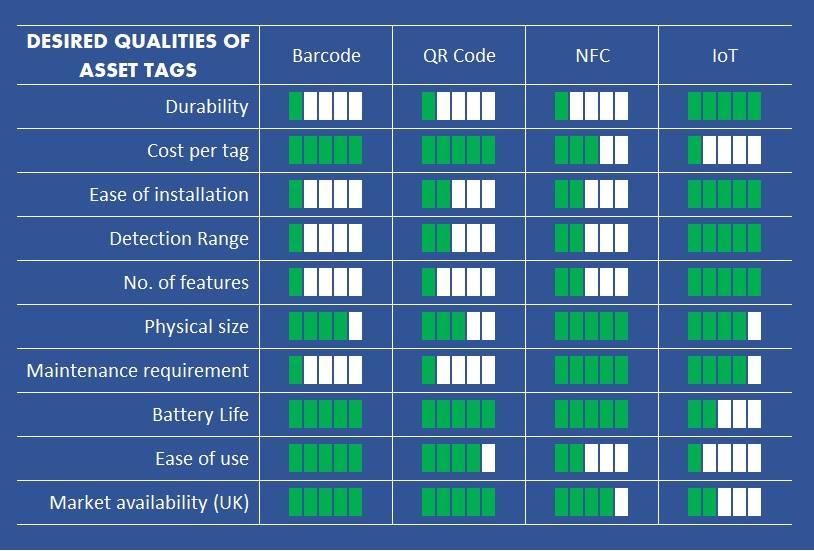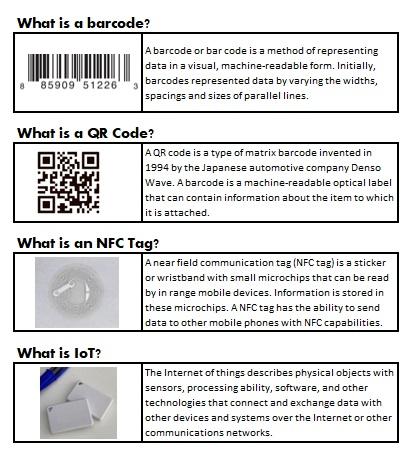It’s highly likely you already have a good understanding of what asset management is, and how to employ it. If not, we recommend reading our blog ‘What is Asset Management? A general overview’.
Below is a detailed comparison of the 4 main types of asset tagging options, including the pros and cons of each.
Firstly, let’s look at a comparison chart that outlines specific positives and negatives of each asset tag type on a one to five scale (green is good);

As you can see from the chart, IoT-based asset tags have some significant advantages over Barcode, QR Code and NFC. There are, however, some disadvantages too.
Tagging an asset gives you access to that asset’s information, usually via specialist software. The ability to obtain this data directly from the asset item itself, makes keeping track of your asset’s history, costs and needs so much easier for your organisation.
Another thing to consider is cost. The cost of asset tags can vary wildly. On one extreme, a Barcode or QR code can be created for free via a website and read via a smartphone. At the opposite end of the scale, you can spend hundreds on advanced, feature-rich IoT-based tags and spend many thousands on specialist software to make use of them. While this blog will not expand on cost in any detail, it is worth noting.
So, when it comes to choosing which asset tag path to go down, it really depends on what features you need, and how much budget you have.
Next, I think it’s vitally important we ensure we understand what each type of tag can be defined as, this is explained in the image below: (Credit to Wikipedia & Techopedia)

At this stage, it is worth mentioning that a few asset tag types have been omitted. This is because they either fall into one of the above categories or they are a specialist subject in their own right. Most notably, GPS tags. This is due to the specific infrastructure and subscribed services they tend to require.
Cost:
If cost is a concern, this is pretty much the cheapest option on the market.
Barcodes at the high end can be purchased as pre-printed, high definition, high tack, glossy stickers. At the low end, you can generate a barcode for free online and print one from home on a sheet of low quality A4 paper.
In addition, the infrastructure required to read and interact with barcodes is both cheap and readily available.
Battery life:
Battery life is great because there isn’t any. A contributing factor when also looking at why they are so cost effective.
Ease of use:
Along with QR codes, Barcodes have to be one of the easiest forms of asset tagging to use. It’s on nearly every product we interact with, even your smartphone can read them.
Market Availability (UK):
Needless to say, Barcodes are prolific. I feel it would be fair to say, the singular most popular asset tagging method in the world. Other than QR Codes I can’t think of a more readily available asset tagging method.
Durability:
A common issue with Barcodes is their susceptibility to damage and wear. You have likely experienced this issue more regularly than you think. How often have you known a barcode not to scan in a supermarket or to find it damaged or marked to the extent it couldn’t be read. It’s one of the reasons Barcodes are such a cheap asset tagging option. We consider the low cost an advantage, while it can also be one of its biggest failings.
Ease of Installation:
Why have we considered this as a disadvantage I hear you ask. Surely, it’s just a sticker, Peel and apply. Easy… right? When you consider some of the slightly more technical products available, a Barcodes apparent ease of installation becomes an issue. While yes, I agree it’s easy to apply a Barcode, consider placement, we often find them in hard-to-reach places meaning they cannot be easily scanned. Because of this requirement to be scanned, the ‘installer’ must ensure the orientation of the barcode is advantageous to the equipment required to read it, that’s not always possible.
Detection Range:
Let’s be a bit more literal with Barcodes, rather than detection per se’ we need to consider the range at which the Barcode can be optically read. Coming back to your likely experience in a supermarket, this can sometimes mean the reader has to not only have near perfect line of sight but must be no more than a few inches away at a push. When considering placement for the tags, this proves to yet again be another disadvantage.
No. of Features:
How many features does a barcode have. Well, from my research, the answer appears to be 4. Those 4 features appear to be fixed in terms of what they can do. Bear in mind Barcodes are an analogue technology and rely heavily on a binary (1’s and 0’s) based system. Variations on the theme do of course exist, but overall, it is an inflexible Asset tagging option.
Maintenance Requirement:
The reason Barcodes scored so poorly in regard to their maintenance requirements, is largely echoed by why they scored so poorly for durability. The sensitivity to wear and damage, means you could be replacing barcodes more often than you think. This might need to be a consideration when considering this asset tagging option.

Cost:
A similar story to Barcodes, if cost is a concern, this is pretty much the cheapest option on the market alongside barcodes (possibly even cheaper).
To again echo the item on Barcodes above, on the high end, a QR Code can be purchased as a custom printed, high definition, high tack, glossy sticker. At the low end, you can generate a QR Code for free online and print one from home on a sheet of low-quality A4 paper.
In addition, a QR code can be programmed and read by a smartphone.
Battery Life:
Again Battery life is great because there isn’t any.
Market Availability:
Possibly one of the easiest asset tagging options to access. QR Codes can readily be ordered online or even generated by you, online via a myriad of websites.
Durability:
It will be no surprise to learn that QR codes, being so similar to Barcodes in the sense that they are ‘printed’ in one form or another, are susceptible to the same issues. If the QR code is defaced, obstructed, or damaged it becomes near useless. If anything, QR Codes suffer more in this regard as Barcodes possess a number string below the Barcode as a backup, QR codes (from my research) do not.
No. of Features:
This was a tough one and could have easily been an advantage. We must, however, compare QR codes to their digital rivals. While a QR code is certainly more flexible than a barcode and interfaces with a digital reader (such as smartphones), they suffer a similar lack of flexibility as Barcodes, in the sense that they can only do one thing, display a string of text.
While a lack of features is clearly a disadvantage, the ability of a QR code to display a string of text recognizable to a device as a web link has its positives.
Maintenance Requirement:
The sensitivity of QR Codes to wear and damage means you could be replacing them more often than you think. This might need to be a consideration when considering this asset tagging option.
Physical Size:
It is simple, they are small. The fact an NFC tag relies on near-field detection rather than line of sight means that can be placed in more advantageous locations. In many cases, NFC tags can be smaller than a penny, making them very useful as an asset tagging medium, especially when the asset is smaller in size.
Maintenance Requirement:
NFC tags are usually metallic and protected by a vinyl-like sticky back layer. They are entirely impervious to issues of surface damage by their very nature of not relying on visual reading methods.
Battery Life
An interesting one. They have no batteries but do contain a memory and are near-field detectable. While a relatively simple technology, when compared to IoT-based asset tags, the lack of a power source to worry about is a huge benefit.
Durability:
While a hardier choice than Barcodes or QR Codes, they are still a light, relatively fragile type of tag. NFC tags differ from Barcode and QR codes in the sense that they possess memory. This means data can be stored on the tag making their loss feel greater. The lack of resilience through additional shielding or casing is where this type of tag fails.
Detection Range:
Due to their ‘near field’ nature, detection range is extremely limited. Usually to just 4cm or less. While the lack of reliance on line-of-sight placement is a positive, the same issues of placement and limited range certainly make these less useful than other asset tagging options.
No. of Features:
Let us not confuse possible uses for actual features. Yes, NFC tags are extremely useful and their adaptability to be used with digital devices is a huge benefit. When it comes down to what can it do, usually they are limited to a single function.
Durability:
When it comes to durability, IoT asset tags and sensors rule the roost. These asset tags can be submersible, ruggedised and made to resist a multitude of environmental factors based on the fact they can be housed within a case.
Ease of Installation:
Surely, these IoT tags can’t be as easy to install as a sticker (like a Barcode, QR Code, NFC etc.)? Why, when they need more elaborate forms of installation methods would you consider their installation as an advantage?
It’s the many ways they can be installed onto an asset that makes them so easy to deal with. Not having to deal with line of sight as the tag can transmit its information over a reasonable distance (we’ll go more into range below), means they can be placed in more hard to reach areas, without later access requirements being a concern when the tag needs to be read. With somethings in life, choice is a bad thing. In this capacity, choice is very much a good thing.
Detection Range:
How long is a piece of string. IoT tags, (perhaps 2nd only to GPS tags) easily wins the range game. From short range, indoor tags (with a detectable range of anything up to 500 meters and sometimes beyond), to ultra-long range (LoRa WAN) asset tags that can send and receive information over many miles. Combined with their many features (see below), the detectable range of this asset tag type is a huge advantage over other asset tagging options.
No. of Features:
At risk of omitting a huge amount of detail here, easily enough for a Blog in its own right, IoT asset tags have a vast range of features. From a single use, read only capability to, multiple data streams being sent and received covering a vast array of functions. There will likely be an IoT tag to suit your needs.

Image by jcomp on Freepik
Cost per Tag:
All that great functionality and range comes at a cost. Expect to pay somewhere in the region of £5.00 at the low end to many hundreds at the high end. Asset volume can certainly be a determining factor when considering if IoT-based asset tags are right for you. If your budget and need are strong, you couldn’t find better, however, if the need isn’t there or the budget can’t handle the many thousands of pounds it costs to implement an IoT asset tag-based system, then this isn’t the right choice for you. Compared to the other asset tagging options this is a significant disadvantage.
Ease of Use:
‘Pick up and play’ are certainly not words you would typically associate with this asset type. IoT-based asset tags require a significant time and knowledge investment to make them work effectively. Knowledge of tag type and system capabilities are things that need to be considered at length when choosing to employ IoT asset tags. Their difficulty in this regard can sometimes be an insurmountable barrier to entry, however, equally, perseverance can yield a system that would provide benefits outweighing the lack of ease of use. Nether-the-less, when compared directly to other asset tagging options, IoT tag complications are a disadvantage.
Market Availability:
As a relative newcomer to the asset tagging market (compared to Barcodes and QR Codes), their availability (within the UK at least) is not great. It gets better every day, but you’ll need to do some digging to find a good supplier. A strong consideration point when choosing to use IoT asset tags is to ensure the system supplier can give assurances on the ability to procure the hardware.
Battery Life:
In the grand scheme of things, the battery life is pretty good. Our research has indicated anything from a 2 to 10yr battery life dependent on the tag’s features, transmit and receive frequency and built-in functions. We must, however, also consider that compared to other asset tagging options available, the simple fact that batteries and their replacement are a consideration, then we need to view this as a con for the tag type.
Footnote: when compared to a GPS-based asset tag, IoT tags have a significantly longer battery life. GPS tags can have as little as a few hours up to a few days. It’s typical, for this reason, to hardwire GPS tags into a permanent power source (ie: similar to a GPS tracker in a vehicle).
Barcodes and QR Codes
Pro’s:
This type of Tag is cheap, easy to use and has excellent availability. If you only require limited functionality or budget is a concern, this would be a great choice for asset tagging.
Con’s:
These tags lack features, making them less adaptable to certain situations. Detection range is next to non-existent, and they can be a problem to maintain.
NFC Tags
Pro’s:
NFC tags can be easy to overlook. Not as cheap as Barcodes and QR codes, nor as functional as IoT. They do, however, possess some fantastic benefits. Their usually small size, low to almost nonexistent maintenance considerations and excellent battery life (they don’t have any) makes these little data-storing asset tags a real contender for being a solid asset tagging choice.
Con’s:
NFC tags are not the most durable, they have a lack of detection range and minimal features. For most, this can put NFC asset tags out of the running when considering which tag type to use.
IoT Asset Tags
Pro’s:
This tag type is by far the most technologically advanced on the market today. Our research has shown they have excellent durability, an almost infinite number of ways they can be installed, a huge detection range and a large number of features. Without a doubt, the most comprehensive, forward-looking asset tagging option on the market today.
Con’s:
The biggest barrier to entry, by far is cost. It is usually the biggest steering point when considering which asset tagging method to use and IoT is certainly up at the high end. They are not the most user-friendly, market availability is still questionable at times and the very fact batteries need to be replaced meaning maintenance is a consideration can be a barrier to entry for some.
If you want a low cost, easy to use asset tagging solution, Barcodes and QR Codes are by far the best choice
If you want the latest and greatest option available and cost isn’t a stopping point, then IoT is at the forefront of asset tagging technology.
Thank you for taking the time to read this blog. We hope you have found it useful and welcome your feedback.
Aran
AGS – Director
Share this post: